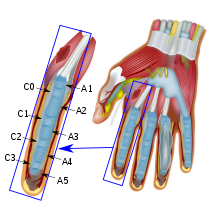Ring band
A ring ligament ( ligamentum annulare ) is a ring-shaped ligament for connecting movable bone structures.
At the elbow there is a ring ligament that partially surrounds the head of the spoke and attaches to the ulna , the ligamentum annulare radii (ring ligament of the spoke). It is firmly woven into the joint capsule of the elbow joint .
A ring ligament also surrounds the footplate of the stapes in the middle ear, the annular stapedial ligament (ring ligament of the stapes). It attaches to the edges of the fenestra ovalis (oval window), forms the end of the inner ear to the middle ear in the oval window and attaches the stapes so that movement is possible.
On the finger or toe there is a ring-shaped reinforcement of the tendon sheaths ( vaginae fibrosae digitorum manus or pedis ), the pars anularis vaginae fibrosae (ring-shaped part of the tendon sheath), which is sometimes (not entirely correctly) called the ring ligament. It lies on the flexor side of the phalanges of the fingers or toes and attaches the flexor tendons to them in a sliding manner. Without this, the tendon would run like a bowstring when flexing ("bowstring effect"), making fine grip more difficult and requiring a significantly larger muscle stroke for the same range of motion on the finger or, conversely, no complete finger flexion possible. Injuries to the ring ligaments occur, for example, in sport climbing , chronic changes are present in the finger that is flickering or in the Pollex flexus congenitus .
